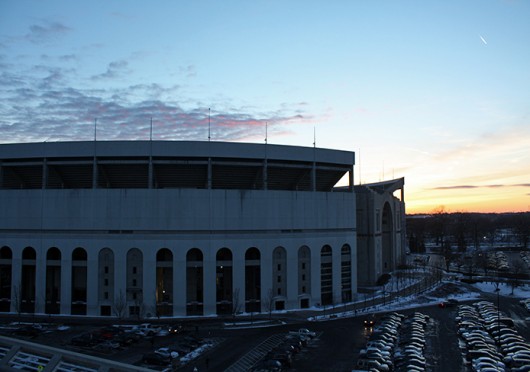
Tours of Ohio Stadium are offered through the Department of Athletics year-round, and the average tour lasts an hour and half.
Credit: Sam Harrington / Lantern photographer
Pam Carroll and her son Cole walked down the steps of Ohio Stadium toward the AstroTurf field. Cole Carroll, a freshman football player at his high school in Phoenix, started down the 50-yard line as his mom pulled out her camera.
The two were on campus for a visit determining whether Cole Carroll might want to enroll at Ohio State when the time comes.
“He’s been waiting for this his whole life,” Pam Carroll said with a smile before taking her son’s picture.
Sights like this are common for Jeff Bordner, who leads many of approximately 250 tours through the ‘Shoe each year. In the last 10 years as a tour guide, Bordner has seen his share of wedding proposals, bar mitzvahs and alumni homecomings, including that of a Columbus native who had retired in Anchorage, Alaska.
“We walked into the locker room, back when we could go into the locker room, and the guy literally got on his knees and started crying,” Bordner said. “I didn’t know what to do. I asked him, ‘Are you OK?’ and he said, ‘You don’t know what this means to me.’”
Stadium tours started after the $150 million renovation of Ohio Stadium between 1998 and 2001, as there wasn’t much to see before that, said Larry Romanoff, director of external relations for OSU football.
“After construction, everything picked up, because people wanted to see the stadium,” Romanoff said. “I had six hardhats in my office to take people out there to see it, because they were still working on the stadium.”
What started as informally showing people around the venue evolved into the formal tour system, where a reservation must be made two weeks in advance.
When a cost of $40 was added to the tour, people continued to come, and when the price went up to $100 a few years later, numbers didn’t drop off, Romanoff said.
Tours are offered through the Department of Athletics year-round, and the average tour lasts an hour and half, according to the Department of Athletics website.
The tour costs $100 total for the first 10 people and an extra $10 per additional adult or $5 per additional student. Children must be in at least sixth grade to attend the tour unless they are with a parent.
Tour-goers visit many behind-the-scenes areas of the stadium, including the press box, club level and band center with an expert guide telling facts and history throughout. People can also venture down to the field and walk on the turf the Buckeyes play on.
As the program continues to grow, the Department of Athletics is looking to make it easier for fans to schedule a tour, said Joel Swaney, assistant director of Buckeyes sports camps who organizes the tours.
“We would like to better accommodate people,” Swaney said. “We’re just trying to figure out the best way as to how.”
Though nothing is set in stone, the goal is to make tours more accessible to people who are in town for a short amount of time and would like a walk-up tour, Swaney said.
“We’re always trying to make the tours better,” he said.
Down on the field looking up into the empty stands, Bordner said he’s been a witness to many sights on these tours, but seeing people from around the world learn about the stadium he loves makes this more than a job to him, he said.
“(My favorite part is) basically people walking into the rotunda who are alums from a long time ago,” he said. “Just the look on people’s faces, it’s fun.”


